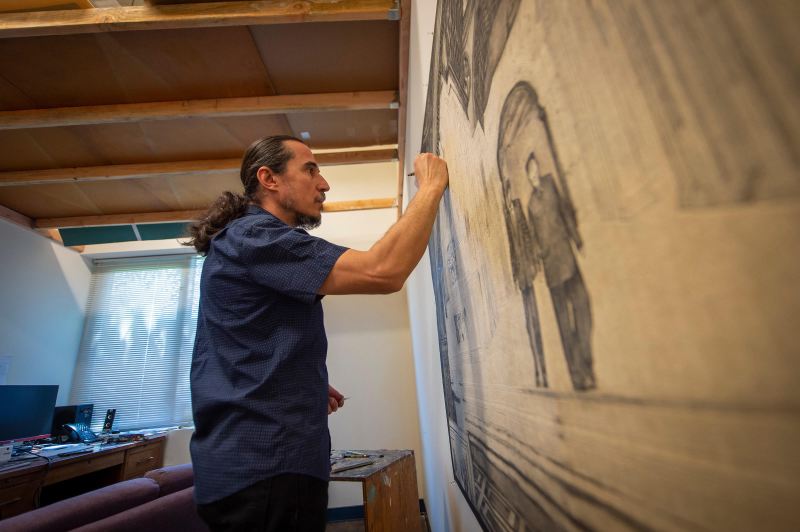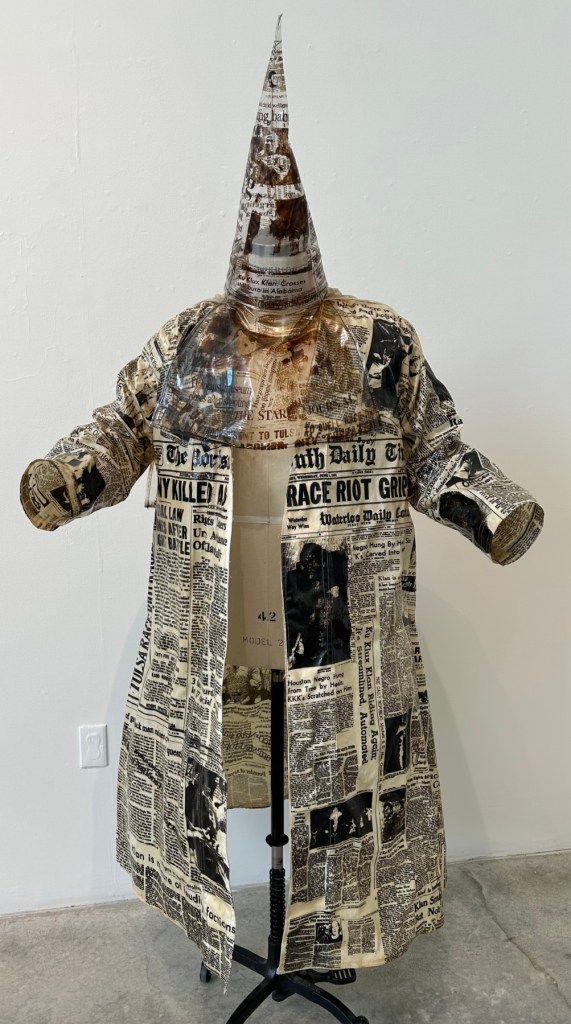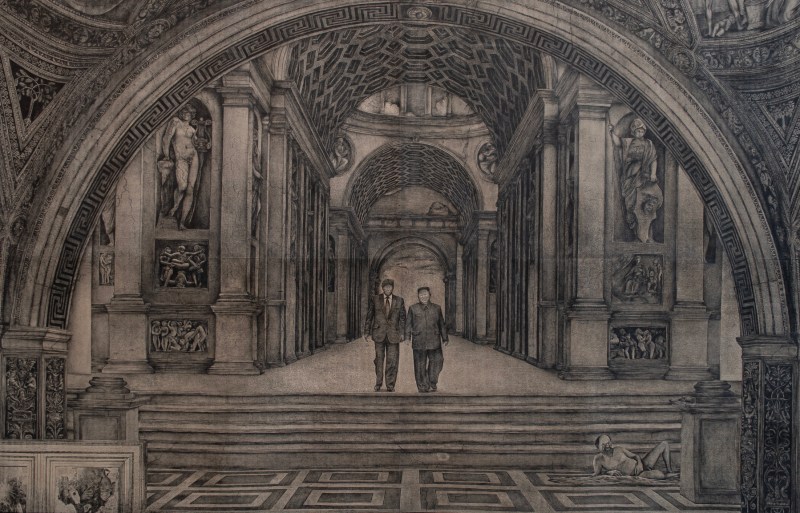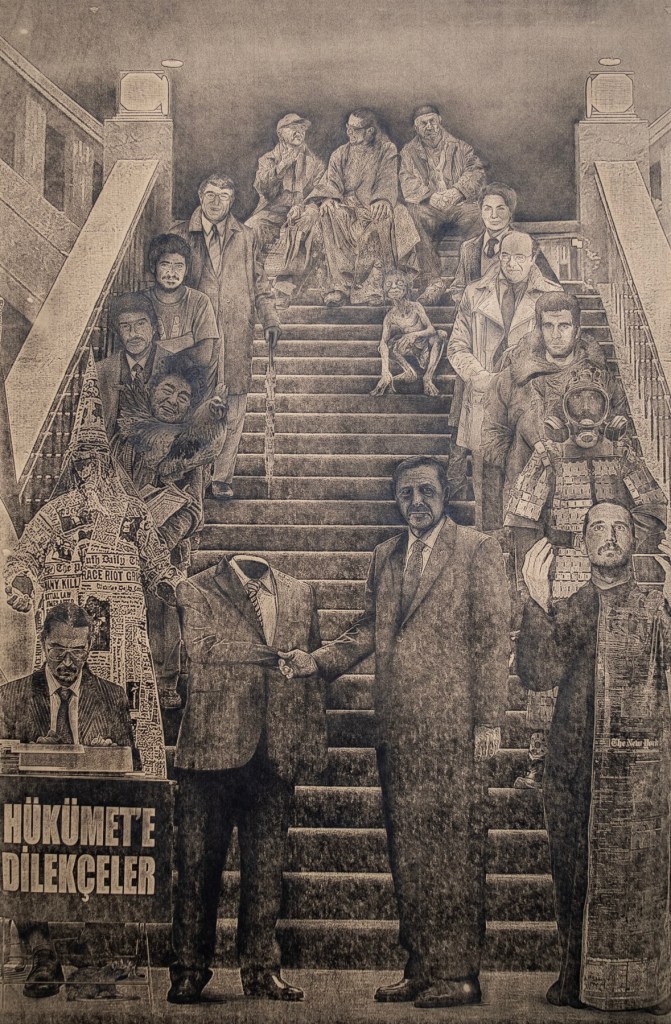
On a cold, gray morning in December 2014, University of Iowa students walking through the sprawling plaza at the heart of the campus encountered a strange, disturbing scene: a Ku Klux Klan effigy, whose white robe was a tapestry of newspaper clippings disgorging a century’s worth of race riots and white supremacist violence in the United States.
Turkish artist Serhat Tanyolacar, who was teaching there at the time, had created and mounted the display. School officials had it removed within hours. The incident prompted extensive press coverage. One student told the local paper it felt “like getting spit in the face.” In a meeting with students, the artist apologized, but it was not enough for one Black doctoral student who took to then-Twitter to say she felt triggered and was hyperventilating.
The disconcerting sculpture is one piece of In-between Poetical Absurdities, a provocative collection of Tanyolacar’s work at the Linfield University Art Gallery in McMinnville. The show, which runs through Nov. 17, is easily the most politically charged show by a faculty member – Tanyolacar is an assistant professor of studio art — in the past few years.
I asked him about the apology.
“I had to,” he replied. “But I cannot blame or say anything about the reaction of Black students, because that’s their right.” The students he spoke with, the 46-year-old professor added, were more receptive when he met with them to explain his intent.
Seeing the sculpture, called In Their Shoes, the lens of this writer’s white privilege enabled me to see what I think Tanyolacar was trying to do. The outline of a hooded man with outstretched arms recalls another, more disturbing image: the infamous 2004 photo from the U.S.-run prison Abu Ghraib in Iraq in which a robed and hooded prisoner, arms outstretched, is forced to stand on a box, humiliated.
With In Their Shoes, which was created in 2010, Tanyolacar subjects white supremacy itself to humiliation. Instead of the ostensibly intended purity and “goodness” of white robes, a century’s worth of horror and racist ugliness is visually subjected to ridicule. “The whole idea,” Tanyolacar told me, “is that the masks don’t hide the racism. There are many nuances, so many layers.”
Another layer: In reproducing the nearly 220 newspaper articles, the artist used tar (which has a long history of use in torture) to produce “screen printed imagery of the racist history of America.”
And it’s not just a sculpture. In Their Shoes is wearable, and the artist has worn it. In October 2010, Tanyolacar did so as a kind of interactive performance art in front of the United States Holocaust Memorial Museum. The dual purpose, according to the catalog for the Linfield show, was to pay tribute to Officer Stephen Tyrone Johns, who had been killed in the line of duty a year earlier protecting museum visitors and staff from an avowed racist, and “to spotlight the increasing prevalence of organized racism and prejudice” in the U.S. As he has done elsewhere in both the U.S. and Turkey, before fleeing that country a few years ago, Tanyolacar talked with passersby, “embodying an anti-ideology symbolized by a modified historical emblem.”
“To me, once you have art in public space, you have to be open to any dialogue,” he said. “Any work displayed or shown in public space becomes public domain. You have to give up authority over the work. Do I get offended? No. It’s part of the work.”

Tanyolacar talks frequently about the importance of context, and with such a politically incendiary show as In-between Poetical Absurdities, context is indeed helpful. He grew up in Turkey, and when I asked about the familial circumstances that presumably compelled him to become an artist, he gently corrected me. The relevant context, in his case, was greater than his family’s leftist sensibilities.
“I was never pushed to be this or be that,” he said, though he added that his father was a gifted painter. Growing up amid atrocities in Turkey, he said, “you live it. You see people getting shot, you see people getting gassed, chasing each other, getting beat up. I grew up with that. Starting in the 1980s, and then the last time I was there in 2015, as I was walking, the police were shooting gas canisters everywhere, just to control. Twelve years ago, my government’s military killed Kurds in Roboski; dozens of people got killed. This is the history of Turkey. It becomes part of you.”
One bit of history seared into Tanyolacar’s psyche happened on Jan. 24, 1993, just a couple of months shy of his 16th birthday. On that day, a car bomb killed the Turkish investigative journalist Uğur Mumcu outside his home in Ankara. Tanyolacar joined thousands in the city who hit the streets in protest, and many thousands more across Turkey.
“That’s when I made my decision to leave,” he recalled. “I had no choice in terms of military service. I’m a conscientious objector. Until you serve your country, until you satisfy your obligation as a Turkish man, [you have] no rights. The only way you can postpone it is living and working in another country or being a full-time student. After I finished my BFA, I just had to run away.”

Tanyolacar’s training over the course of a decade in American schools included drawing and painting in a variety of media, sculpture, welding, and digital media. But his primary interest, as is immediately apparent when you walk into the Linfield gallery, is printmaking. I asked him why.
“That’s a good question,” he said during an interview a few days after the opening. “You can use printmaking in many ways. You can have editions, you can have multiplication, or you can have unique prints. Everything here is a single monotype, or what we call unique prints. I’m very interested in that idea.”
Tanyolacar’s dense imagery borrows from and pays tribute to an eclectic mix of artistic works spanning centuries and representing the gamut of painting, literature, film, and television.
In one instance, the Italian Renaissance painter Raphael’s early 16th-century fresco School of Athens is the starting point. Tanyolacar has replaced the congregation of Ancient Greek philosophers and scientists gathered in a magnificent temple in Raphael’s painting with three figures. Facing front and center are Donald Trump and North Korean President Kim Jong Un and, on a lower floor off to one side, in roughly the same posture as Diogenes of Sinope in the original, a smiling and buck naked Allen Ginsberg, whose 1956 poem Howl led to a free-speech case in California. Several relief structures in the fresco, to which the artist regards his laser-engraved relief print as an homage, have been replaced with the Kama Sutra; another, if you look closely, is an image of police officers trying to stop the Jan. 6, 2021, breach of the U.S. Capitol.
Serhat says that “three layers of critique” are at work: the political wreckage of Trump’s presidency, limits on academic and artistic freedom, and Western stereotypes over the Orient and non-Western.
Trump (along with Turkish President Recep Tayyip Erdoğan) takes a beating in Tanyolacar’s work, more vigorously in some than others. On the relatively tame, G-rated end is a 2023 piece titled Lada Deal, which the artist terms a celebration of the former president’s exit from the political stage as he drives a Lada, a vehicle associated with Russian President Vladimir Putin. More than 20 birds flutter around it — mostly crows, but also what appears to be an eagle and, on the bumper, a vulture. The artist elaborates in the catalog:
“The direct reference to Hitchcock’s The Birds is evident as the former American President, akin to the birds in the film, attracted and charmed attacks on the nation. These symbolic attacks represented issues like women’s rights, education and immigration, reflecting the profound impact of his presidency.”
On the other, exuberantly X-rated end of the spectrum is a piece that got Tanyolacar slapped down by another institution that wasn’t prepared for an artist to go full Howl. Riffing off an orgy scene in Patrick Süskind’s 1985 novel Perfume: The Story of a Murder, Tanyolacar’s four-panel laser-engraved relief print features a couple dozen Trumps in the two panels on the left having every kind of sex imaginable with both themselves and others — Mike Pence, former Secretary of Education Betsy deVos, and Putin among them — a visual depiction of an unclothed emperor’s unbridled narcissism taken to an absurd but somehow logical extreme.
The piece, titled Death of Innocence, had appeared in an exhibition in the University of South Florida’s Marshall student center with no problem. But when Florida’s Polk State College — where Tanyolacar was teaching part-time in 2018 — asked for submissions for a faculty art fair and he submitted Death of Innocence, the school balked, with vague objections like “too much” controversy, according to the Tampa Bay Times.
Anti-censorship advocates stepped in, as they had in Iowa. The more liberal freedom-of-speech protections afforded in America notwithstanding, Tanyolacar was clearly not living in the “innocence” world represented by the two panels on the right, which are inhabited by artists, poets, musicians, and even Atticus Finch from To Kill a Mockingbird. That, the artist told the Times, was “the reality I would like to enjoy.”
“I’m not going to say the United States has a fully functioning democracy, absolutely not,” Tanyolacar told me. “But in terms of the U.S. Constitution — and I’m mostly talking about freedom of speech and expression — I think that is the most valuable asset this country has offered and given me. There is no way I could do in Turkey some of the things I’ve done in this country. Can you imagine me having Erdoğan having an orgy? I would be killed. I would be killed the next day.”
Or at the very least, he’d face prison time. That’s what nearly happened to a Turkish doctor a few years ago when he posted on Facebook images of that nation’s far-right president that paired his facial expressions with those of Gollum from Peter Jackson’s film, The Lord of the Rings. According to a 2016 article by Reuters, Turkish prosecutors at that time had accused more than 1,800 people of insulting the Turkish president, which is punishable with imprisonment.

Tanyolacar’s artistic response is tucked into an embossed graphite drawing at the Linfield show. In Bindik Bir Alamete Gidiyoz Kiyamete (We Are Going to a Sign of Doomsday), Erdoğan is featured “in a state of delusion” surrounded by Turkish citizens who have lost their lives “due to the government’s actions and fascist forces.” Gollum is in there, too, as are several images of a robed Tanyolacar during the performance art protests he staged in Turkey before fleeing the country once and for all.
Tanyolacar has a thing for robes. Another that he’s worn in performance and featured in the exhibition is a golden brocade kaftan, a luxurious, decorative robe of the type Ottoman sultans would have worn centuries ago. He’s dropped his robed self into several prints in the show. In what the artist called his Elveda (Farewell) public performance in March 2015, he wore the kaftan while walking around Ankara and Instanbul, talking with people. The catalog describes the piece and how it played out:
“The genesis of the Farewell performances can be traced back to Tanyolacar’s artistic journey in the United States, where he embraced the role of the ‘Oriental other.’ His intent was to scrutinize the hypothetical existence of contemporary Ottoman identity, often associated with neo-Ottomanism. Within this artistic framework, Tanyolacar fervently delved into the complexities of intertwining Oriental and Ottoman identities, both within the Republic of Turkey and in the broader context of Western society.”
Tanyolacar’s critique of neo-Ottomanism — a kind of glorification of the past intended, for opportunistic political reasons, to drive the present — is a central part of his work. While it is legitimate to appreciate and honor the artistic contributions and aesthetic sensibilities of the Ottoman past, he said, neo-Ottomanism is more of an ideological perspective closely associated with Erdoğan and his government — a Turkish version of “Make America Great Again.”
“It’s nationalism; it’s an obscure nationalism,” he said. “Because you’re reaching back to 1400s culture and adapting it to today’s world.” Later, he put it another way: “It’s an absurd, commodified national and cultural identity.”
On the final day of the Farewell performance, Tanyolacar took his show to Erdoğan’s palace.
“As soon as they saw me getting close to the main entrance, we got circled,” he recalled. “They were like, ‘They have a camera, take the camera!’ They grabbed the camera from my cameraman, and [told us] ‘You have to delete’ the pictures. We were moved to a room, and we stayed there about an hour and were interrogated. They asked a bunch of questions and let us go.”

Virtually all the pieces in In-between Poetical Absurdities grapple with the politics and social upheaval, past and present, in both Turkey and America. An elephant, the emblem of the Republican Party, takes a dump on the White House lawn while the Democrats’ donkey sits idly by, watching. In a print titled Justice, images of Black Americans killed by police stand in front of a federal justice building. A mashup of U.S. history and the Ottoman aesthetic, My Sultan Your Sultan What Is the Difference?, portrays American presidents and imagery evoking specific events (such as the Abu Ghraib prisoner mentioned above) with a map of Ottoman sultans as the base. For his statement as a conscientious objector, Tanyolacar screen-printed the defiant text onto pieces of a Turkish military uniform.
“For Tanyolacar, censorship is an expected … part of the artistic process,” said Clarisse Taboy, writing for Artists at Risk Connection a few years ago. The group, under the auspices of PEN America, has come to his aid on more than one occasion.
“Rather than discourage him from continuing to create, it only invites him to engage further into the dialogue with his audience and direct the artistic vision for his next artwork,” she writes. “He challenges artists to not produce physical pieces for the sake of creating artwork, but create art that responds to today’s circumstances and triggers positive change.”
So far, the response to In-between Poetical Absurdities has been mostly appreciative and encouraging, Tanyolacar said. Two students walked out of his opening lecture, although it wasn’t clear why or if it had anything to do with the show’s content. The adjectives he’s heard most frequently are “daring” and “courageous.” But he realizes, too, that Linfield University in Yamhill County is not Reed College in Portland. Last winter, when video was released of yet another Black man, 29-year-old Tyre Nichols, being assaulted by five Memphis police officers (who have since been charged with murder), Tanyolacar spent more than an hour driving around McMinnville to see if anyone was protesting. No one was.
“My existence at this academic institution is not just as a teacher or educator, but also I’m a political activist,” he said. “I would love to see students react to what is going on in the Middle East, and there is nothing.”
“In terms of free speech and expression, this country is one of the best, but still, you don’t use it,” he said. “The fear is losing your comfort. I don’t know, with all these things happening, I would like to see more people be conscious, be aware, and act. Without the public reaction, without the visibility in public space, without that space being utilized, the Constitution has no function. It’s just words.”
This post was originally published on this site be sure to check out more of their content.







